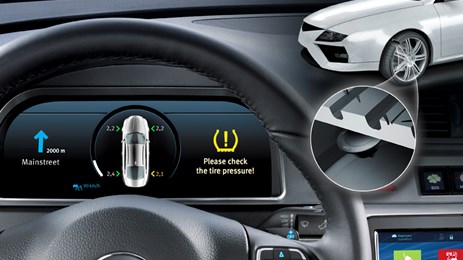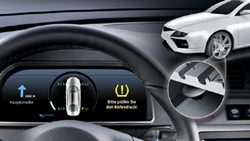What is TPMS?
More safety, more comfort and less fuel consumption.

TPMS has been a mandatory fitment on newly-registered vehicles from November 2014
TPMS stands for Tyre Pressure Monitoring System.
It is a highly effective security system that alerts the driver by displaying a warning sign on the dash of the vehicle when a tyre pressure falls 20% below the normal value.
Innovative TPMS advantages:
- Increases safety
- Lowers fuel consumption
- Reduces tyre wear
- Improves braking and stopping distance
- Improves handling and reliability
Indirect vs Direct TPMS
Indirect systems:
These systems evaluate signals from a vehicle’s anti-lock brake system (ABS) to compare the speed of the wheels. If the system detects a difference in wheel speeds and this is not attributable to the driving situation, a warning lamp on the instrument cluster will illuminate.
 Direct systems:
Direct systems:
In a direct system each wheel/tyre is equipped with a sensor that directly measures the tyre pressure and depending on the vehicle, measure temperature. This information is transmitted wirelessly to a control unit which analyses the data and displays a warning on the instrument cluster if low pressure is detected.
- Direct systems are faster and provide more precise
- Direct systems have the potential to display the pressure and temperature of each tyre individually, even when the vehicle is stationary
- Direct systems do not have to be recalibrated if the tyre pressure changes due to an increase in load or a tyre change (however direct systems do require a sensor/vehicle relearn when moving or replacing sensors – this may be automatic depending on the vehicle)
TPMS Opportunities
The EU and DVSA Legislation
Since November 2014, TPMS became a mandatory fitment on all new M1-class vehicles (cars and motor homes).
In January 2015, TPMS became part of the annual MOT for all cars fitted with the technology and registered after the 1st January 2012. Up until May 2019, a faulty TPMS sensor was only an advisory on the MOT certificate, but now it is classed as a major fail!
Huge Profit Opportunities!
With millions of vehicles now fitted with TPMS, this has created new business opportunities for dealers, garages and tyre service businesses. The demand to replace and repair TPMS sensors and number of MOT failures is rising at a significant rate. Garages should therefore be equipped with the right tools in order to meet this service or risk losing business to a competitor.
TPMS Tools and Sensors
Take the pressure out of tyre changes:
As a brand of Continental, VDO has the knowledge of a leading international tyre specialist to provide you with everything for the perfect tyre service.






